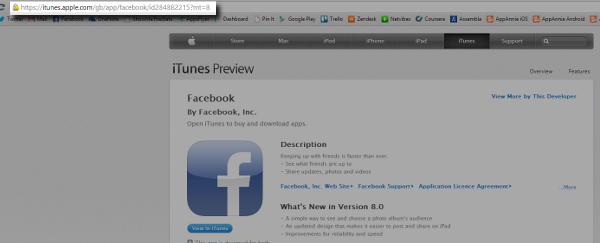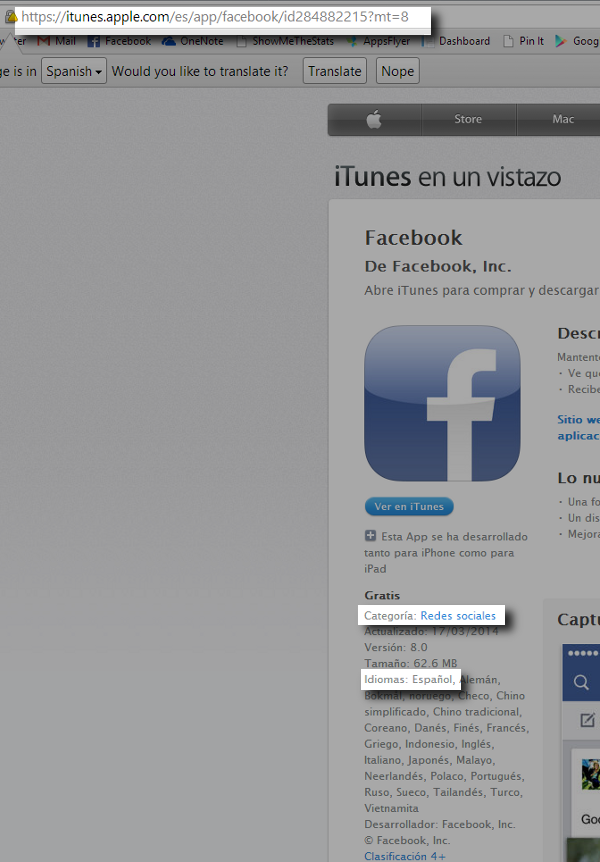Market Research when Localizing your App
31 Mar 2014
As an app’s user base grows, it’s likely the developer will start to consider localizing the app; that is they will consider translating the app and user experience into a new language to grow in another country or local. There are numerous articles and guides written about the process of localizing an app for another language, but I want to specifically address the process of researching competitors in a localized market.
The Apple App Store has no functionality to search apps by language. In other words, there’s no built-in way to see apps that offer specific languages (or are only available in one language). This makes it very difficult to see who else will be competing for your same users.
However, I’ve found a trick that allowed me to search for apps in a certain language, which can be a great help in finding local competitors. For the example below, I’ll illustrate how to search for social media apps that are localized for the Spanish language.
First, you’ll need to navigate on the web to the App Store in the language and category you want to research. The easiest way to do this is view your own app, or a direct competitor’s app first in your native language. I’ve used the example of Facebook below:

Notice the URL of the app in my case contains /gb/, which denotes the country (and language) of the app store I am viewing. However I can change this. To see this same app in the Spanish App Store, all I need to do is change this to /es/.
Notice below that once I change the URL, the meta data of the page changes as well (as does the app description if the app already has a localized version). This is important for the next step of the research process – in particular the localized version of the category and the meta data that denotes language.

Now we have three key bits of information: the URL format for the local app store, the localized meta data for language and the localized meta data for category. Using the Google site search function, we can put this all into a Google search. As you can see below, I am searching for all pages indexed in Google that are within the Spanish App Store site, and contain exactly the phrase that corresponds with the meta data that indicates the app is in the social category and available in the Spanish language.

As you can see, the search results returned will link me to pages within the Spanish App Store with Spanish language social apps. Job done!

This is a huge volume of search results so I can continue to refine the results to just my potential competitors by adding additional keywords (in the local language of course – Google Translate can help you out here) to my Google search.
Understanding local competitors can be key in successfully localizing your app. This is one way to find out who the players are in your new space. Any other techniques you know for finding competitive apps when localizing?
A quick one before a more thorough summary of my week at Mobile World Congress – I gave this talk as part of the Advanced User Interfaces Seminar at Mobile World Congress 2014 (#mwc14) hosted by the UK’s ICT KTN. It covers the challenges and proposes some solutions in designing and testing apps and mobile services geared towards a non-traditional audience such as elderly, disabled or young users.

I was recently quoted in an article rounding up predictions for mobile in 2014 (20 Mobile Industry Expert Predictions for 2014). There were a lot of comments about mobile commerce, mobile marketing budgets increasing and tracking, but no one else seemed to share my prediction:

Building 23snaps has been an amazing learning experience in so many ways, but none more-so than the wake up call that the vast majority of consumers, across any market, are not tech-savvy millennials who will forgive UI inconveniences for the sake of using the latest technology. At 23snaps, many of our users are using a technology other than email for enjoying family photos for the very first time. That can be hard enough for them on the computer, but add a new smartphone into the mix and suddenly there are a lot of our customers who need, if not hand-holding, some excellent sign-posting to help them figure out what to do next.
I would like to think that I’m not the only one who noticed this trend. As I mentioned in my prediction, iOS 7 was a jarring experience for many users. In fact the AARP, a membership community and non-profit for US over-50s, actively discouraged its members from upgrading to iOS 7 as late as 30 October, 2013 (iOS 7 was released in June). They said:
“The font is very light and may be hard to read for some. The icons appear flat and move quickly across the screen, causing some people to report dizziness.”
If Apple thinks this recommendation from AARP is no big deal, they should check the membership roster. AARP has over 40 million members.
But the bias towards user interface design that favors the tech-savvy is pervasive through the entire industry – and at times this is dramatic enough to confuse even the millennials. Look, for example, at the Facebook ‘Other’ inbox, for most people a hidden repository of lost birthday wishes, invitations and requests.
An enormous audience has access now to technology that should make their lives easier in every way. But instead the applications and services available leave many of them confused and frustrated. In the last few years, the audience of non-digital natives using the latest technology has become the majority but products and services aren’t catering to them, missing out on profit and growth opportunities.
2014 needs to be the year that designers and developers begin considering the experience for someone who doesn’t understand that three horizontal lines means ‘Menu’ or that an eight-pointed star means ‘News Feed,’ or even what a ‘News Feed’ is. There is a balance to be struct between spoonfeeding digital natives, but creating a beautiful, usable product, that signposts the most important elements for those who are discovering them for the first time.
The other day, a conversation in the office about how to generate more press coverage for our startup led to some questions – what do the major tech blogs consider newsworthy? What do they usually write about? Are there any publications that provide more coverage for startups, or article topics that drive more of the news?
A quick glance turned into a longer look, and the result was some analysis on a full week’s worth of content (between 1 and 7 August, 2013) on five major tech blogs – TechCrunch, The Next Web, WIRED news, TIME’s Techland, and CNN.com’s tech news section. There were over 540 articles to analyse and the results were fascinating (and I wonder if the publications themselves look at the breakdown of their content in this way).
To summarize the information gathered, I’ve created this handy infographic:
Here are a couple of interesting takeaways:
– Only 11% of a week’s worth of tech press was about startups launching. [Tweet this stat]
If you want to get coverage for a new venture, you’d better have a good hook because this type of story clearly doesn’t get as much coverage as, say, new feature releases from Google or a news from Apple. Startups in general drove about 25% of the press for the week analyzed.
– TechCrunch devotes about 43% of its coverage to startups; TIME Techland only 8%. [Tweet this stat]
It’s not surprising to see a large percentage of TechCrunch’s coverage is about startups, but it is interesting that other top tech blogs spend so few words on the space. WIRED was barely any better at 9% and The Next Web and CNN had slightly fewer than 1 on 4 articles about startups.
– Apple, Facebook, Microsoft and Google account for 20% of the coverage across major tech blogs. [Tweet this stat]
The four companies alone were the subject of 1 in every 5 articles posted by the five sources.
– 50% of the new ventures covered by WIRED’s tech news blog were launched from a university research center. [Tweet this stat]
Want coverage on WIRED? Better team up with an established university. Or go space. WIRED loves a good astronomical discovery.
– While 40% of startup coverage was about company launches, new features and fundraising also made the news. [Tweet this stat]
If you’re past launch but still considered a start up, don’t write off tech press. 6 in 10 of the articles about startups across all five tech blogs were about something other than the company launch. Primarily this was related to startups launching new features (25% of startup coverage) and fundraising (11% of startup coverage), there were stories about acquisitions, hiring and general business news (such as trend pieces and small companies responding to business and political news like the NSA leak).
Of course this is a limited data set, and I’d love to do the same analysis for a larger sample of articles and more sources. That said, I believe this to be a good snapshot of tech press and how it relates to startups.
Got any thoughts on these data? Does this seem to match with your experience and knowledge of the tech press? Let me know in the comments below.


 Meaghan Fitzgerald is a marketer and entrepreneur building and growing consumer and gaming products and experiences. A Silicon Valley native, she started her first company, DormWise, in 2006 which she later sold in 2009. Meaghan spent 7 years in London in early stage consumer startups, two years at Xbox as a product marketer for Minecraft, and is currently the head of product marketing for VR experiences at Facebook and Oculus. Meaghan writes here about business, technology, gaming, and marketing. She has been named a top
Meaghan Fitzgerald is a marketer and entrepreneur building and growing consumer and gaming products and experiences. A Silicon Valley native, she started her first company, DormWise, in 2006 which she later sold in 2009. Meaghan spent 7 years in London in early stage consumer startups, two years at Xbox as a product marketer for Minecraft, and is currently the head of product marketing for VR experiences at Facebook and Oculus. Meaghan writes here about business, technology, gaming, and marketing. She has been named a top